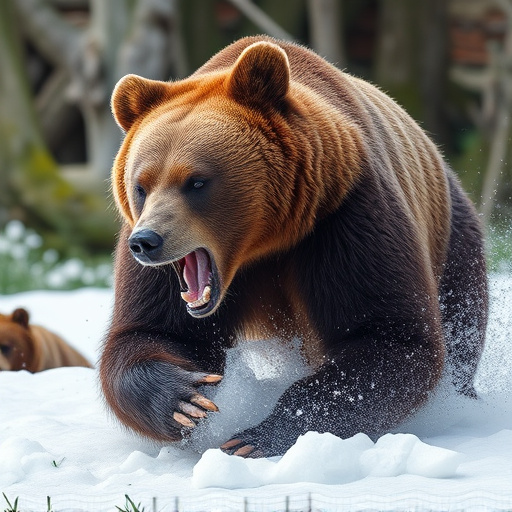Bear spray foggers, using capsaicin from chili peppers or oleoresin capsicum (OC), are crucial for self-defense in Alaska's bear country. With a minimum 15% active ingredient percentage, these sprays deter and temporarily incapacitate bears during encounters. Proper usage, including aiming at the face and eyes, and understanding environmental factors like weather and distance maximize their effectiveness. Regular testing and following manufacturer guidelines ensure optimal protection during outdoor adventures.
Alaska’s rugged wilderness presents unique challenges, especially with bear encounters. Understanding bear spray foggers is crucial for adventurers’ safety. This guide delves into the mechanics of these defense systems, focusing on the power of active ingredients and their percentage labeling. We explore how to select the ideal bear spray tailored to Alaska’s diverse environments. Learn essential tips for effective use and safety measures to ensure optimal protection during your outdoor adventures in this stunning yet unpredictable landscape.
- Understanding Bear Spray Fogger Defense Mechanisms
- Deciphering Bear Spray Active Ingredient Percentage Labeling
- Choosing the Right Bear Spray for Alaska's Environments
- Effective Use and Safety Tips for Optimal Protection
Understanding Bear Spray Fogger Defense Mechanisms
Bear spray foggers are a popular defense mechanism for those adventuring in Alaska’s wilderness. To understand their effectiveness, it’s crucial to know how they work and what goes into them. Bear spray is designed to incapacitate an attacking bear temporarily by irritating its eyes and respiratory system. The active ingredient percentage varies, with common components including capsaicin, a compound derived from chili peppers, and other chemicals that create a fog-like effect when sprayed.
This method of defense works best as a deterrent, providing users with a crucial few seconds to escape or defend themselves. The spray creates a barrier of irritants that can reduce the bear’s ability to see and breathe, stalling its attack long enough for the individual to retreat to safety. However, it’s important to note that successful deterrence depends on proper usage, including aiming for the face and eyes of the bear, and understanding that no spray is 100% effective against determined attacks.
Deciphering Bear Spray Active Ingredient Percentage Labeling
When shopping for bear spray, one of the most crucial factors to examine is the listed percentage of the active ingredient. This information provides insight into the spray’s potency and effectiveness against bears. Typically, the active ingredient in bear spray is capsaicin, derived from chili peppers. The label will display this concentration as a percentage, indicating how much capsaicin is present in each can.
Understanding these labels becomes essential for users to make informed decisions based on their specific needs and the types of bears they might encounter. A higher percentage suggests more capsaicin, potentially offering greater bear deterrence over longer distances. However, it’s not solely about the number; factors like spray pattern, weather conditions, and proximity to the bear also play significant roles in determining the spray’s success as a defense mechanism.
Choosing the Right Bear Spray for Alaska's Environments
When selecting bear spray for defense in Alaska’s diverse environments, understanding the active ingredient percentage is key. The most effective options typically contain a high concentration of active ingredients like capsaicin or oleoresin capsicum (OC), which have proven track records against bears. These ingredients create a potent fog that can deter aggressive bears effectively.
Choosing bear spray with at least 15% OC or a similar active ingredient percentage ensures maximum protection in various settings, from dense forests to remote coastal areas. It’s important to consider factors like weather conditions and the type of bear encounters likely in Alaska when making your selection, as these can impact the spray’s range and effectiveness.
Effective Use and Safety Tips for Optimal Protection
Using bear spray effectively requires understanding its active ingredient percentage and applying it correctly for optimal protection. Look for a product with at least 15% capsaicin, the active ingredient known for its effectiveness against bears. This concentration ensures the spray creates a sufficient barrier between you and the bear, causing it to deter or divert an attack. Always test the spray in a safe environment before venturing into potential bear country to familiarize yourself with its range and effect.
Safety tips are crucial for responsible use. Ensure you follow manufacturer guidelines regarding distance, angle, and duration of application. Keep your spray readily accessible and ensure all group members know where it is located. Never run or turn your back on a bear; instead, make yourself appear larger by raising arms or clothing. If a bear attacks, use the spray as directed while retreating slowly. Remember, prevention through awareness and proper preparation is key to safe outdoor adventures in bear country.
When venturing into Alaska’s diverse landscapes, equipping yourself with the right bear spray fogger is a game-changer. Understanding the defense mechanisms, deciphering active ingredient percentages on labels, and choosing the suitable spray for specific environments are key steps to ensuring optimal protection. Always follow safety tips and guidelines for effective use, as your preparedness could be a testament to keeping you safe during encounters with these powerful creatures.
